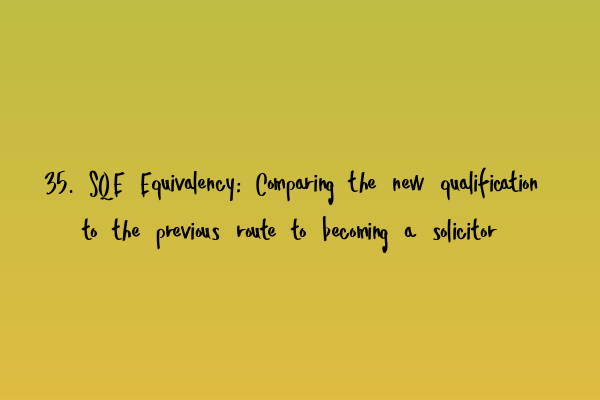35. SQE Equivalency: Comparing the new qualification to the previous route to becoming a solicitor
Aspiring solicitors in the UK have long followed a prescribed route to qualification. However, with the introduction of the Solicitors Qualifying Examination (SQE), the landscape of legal education and training is undergoing significant changes. In this article, we will explore the SQE equivalency and compare it to the previous route to becoming a solicitor.
The Traditional Route: LPC and Training Contracts
Before the SQE, the traditional route to becoming a solicitor consisted of completing a qualifying law degree or Graduate Diploma in Law (GDL), followed by the Legal Practice Course (LPC), and finally securing a two-year training contract with a law firm.
The LPC served as the bridge between theoretical legal education and practical legal training. It covered subjects such as civil litigation, contract law, and professional conduct, aiming to equip aspiring solicitors with the practical skills required in their future legal careers.
Training contracts, on the other hand, provided the opportunity for trainee solicitors to gain hands-on experience in a legal practice setting. It involved rotations across different departments of the firm, allowing trainees to explore various areas of law before qualifying as a solicitor.
The Introduction of the SQE: A New Qualification
The SQE was introduced by the Solicitors Regulation Authority (SRA) to replace the previous route to qualification, with the goal of ensuring consistent standards and improving accessibility to the legal profession.
The SQE consists of two stages: SQE1 and SQE2. SQE1 assesses legal knowledge through multiple-choice questions (MCQs) and is open to all candidates, regardless of their educational background. It covers subjects such as constitutional law, criminal law, and land law.
SQE2, on the other hand, assesses practical skills through a series of assessments, including written tasks, client interviewing, and advocacy. It is designed to test a candidate’s ability to apply legal knowledge in real-world scenarios.
Comparing the SQE to the traditional route
Now that we have an understanding of the SQE, let’s compare it to the traditional route in terms of key aspects:
Required Qualifications
Under the traditional route, a qualifying law degree or GDL was a prerequisite. However, under the SQE, candidates can qualify without a specific academic qualification, as long as they pass the SQE1 and SQE2 assessments. This change opens up the legal profession to candidates with diverse educational backgrounds.
Structure and Duration
The traditional route involved completing a law degree or GDL followed by the LPC, which took an additional year of study. Additionally, securing a training contract could take time, leading to an overall longer route to qualification. The SQE condenses the process by assessing legal knowledge and practical skills in a more streamlined manner.
Cost
The cost of pursuing the traditional route can be significant. The fees for a law degree, LPC, and potential postgraduate study can add up. In addition, earning potential during the training contract period may be limited. The SQE offers a standardized and potentially more cost-effective route to qualification.
Flexibility and Accessibility
The traditional route often required full-time study and immersive training contracts, making it difficult for individuals with existing commitments to pursue a legal career. The SQE, on the other hand, offers more flexibility by allowing candidates to study and prepare for assessments at their own pace, making it accessible to a wider range of individuals.
Preparing for the SQE
To succeed in the SQE, candidates need to ensure they are well-prepared. Comprehensive study materials, interactive mock tests, and SQE sample papers are invaluable resources that can help candidates familiarize themselves with the exam format and improve their performance.
Check out the following related articles for more information:
- Conquer the Multiple Choice Questions (MCQ) in SQE1
- Interactive mock tests for SQE: Enhancing engagement and learning
- SQE Sample Papers: Practice for Exam Success
- Focus Areas in SQE1 and SQE2: Mastering Key Concepts
- Adjusting Your SQE Strategy Based on Mock Performance
In conclusion, the introduction of the SQE has brought significant changes to the route of becoming a solicitor. While the traditional route had its merits, the SQE offers a more flexible, accessible, and potentially cost-effective path to qualification.
Aspiring solicitors should familiarize themselves with the requirements and structure of the SQE and make use of available resources to prepare for the assessments. With proper preparation, dedication, and the right support, they can navigate the new qualification successfully and embark on a rewarding legal career.
